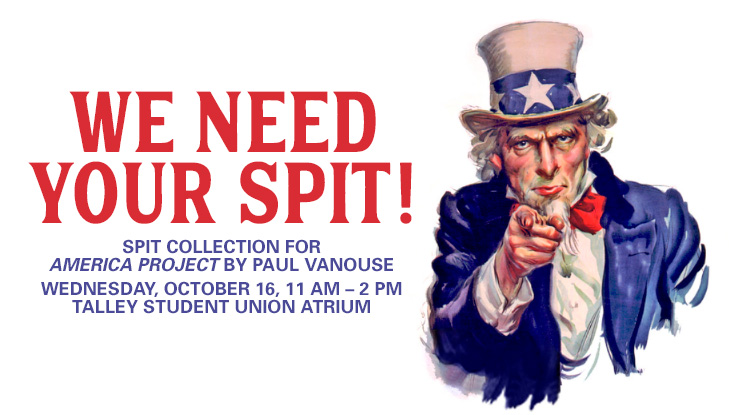
We need your spit!

Artist Paul Vanouse needs your spit for art.
On Wednesday, Oct. 16 from 10:00 a.m.-2:00 p.m. in Talley Student Union Atrium, students and other visitors will be offered a one-ounce cup of saline solution and asked to swish for 30 seconds, then to deposit the solution into a common spittoon. Vanouse, a bioart artist based in Buffalo, NY, will extract the DNA from the combined spit samples (don’t worry, your DNA will not be individuated or retained) and processed as a whole to make iconic DNA Fingerprint images of power—such as a crown, warplanes, and a flag.
Part of Vanouse’s work entitled “America Project,” these images will be visible as video projections of electrophoresis gels (often called “DNA fingerprints”) throughout the art-science exhibition Art’s Work in the Age of Biotechnology: Shaping Our Genetic Futures, which opens the following evening on Oct. 17 at the Gregg Museum of Art & Design and the NC State University Libraries.
Participation in this project is free and open to the public.
Vanouse’s “America Project” premiered at the Esther Klein Gallery, Philadelphia, in 2016, and received an Award of Distinction at Prix Ars Electronica, Linz, in 2017. He is an artist and professor of art at the University at Buffalo, NY, where he is the founding director of the Coalesce Center for Biological Art. Interdisciplinarity and impassioned amateurism guide his art practice. His bio-media and interactive cinema projects have been exhibited in over 25 countries and widely across the U.S.
Art’s Work in the Age of Biotechnology: Shaping Our Genetic Futures is an art-science exhibition shown at the Gregg Museum of Art & Design, in the physical and digital display spaces of the Libraries, and on the grounds of the North Carolina Museum of Art. The exhibition, which runs through March 2020, is aimed at raising awareness about genetic engineering, biotechnologies, and their consequences through the lens of art and design. Art’s Work is organized by the NC State University Libraries and the Genetic Engineering and Society Center.